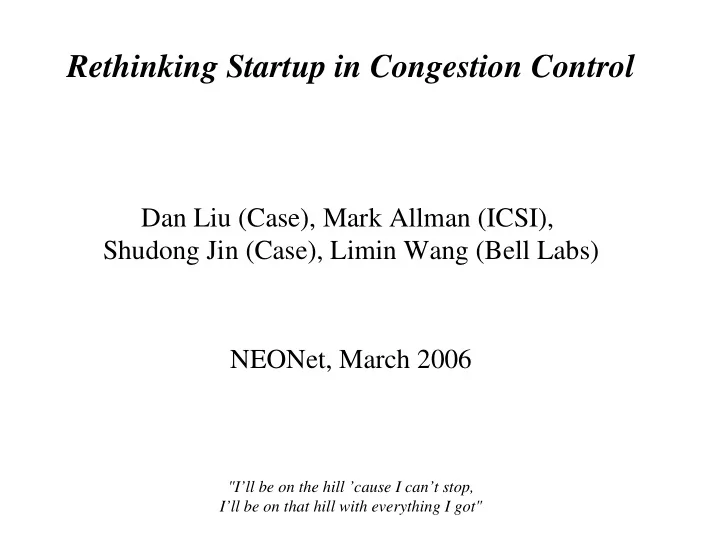

Rethinking Startup in Congestion Control Dan Liu (Case), Mark Allman (ICSI), Shudong Jin (Case), Limin Wang (Bell Labs) NEONet, March 2006 "I’ll be on the hill ’cause I can’t stop, I’ll be on that hill with everything I got"
Fundamental Question At what rate should transmission begin when sending across an unknown, best-effort, packet-switched internetwork? We have a workshop answer OK, a small workshop handwave Allman 2
Current Answer Slow Start 35 30 Congestion Window (segments) 25 20 15 10 5 0 1 2 3 4 5 6 Round-Trip Time Allman 3
Current Answer (cont.) However, slow start can be really slow e.g., in large bandwidth-delay product networks Slow start can underutilize a bunch of available capacity Allman 4
Current Answer (cont.) Example #1 500 RTT=0.05sec 450 RTT=0.1sec Congestion Window (segments) RTT=0.5sec 400 350 300 250 200 150 100 50 0 0 0.5 1 1.5 2 2.5 3 3.5 4 4.5 Time (sec) Allman 5
Current Answer (cont.) Example #2 120 Avail. Capacity Congestion Window (segments) 100 80 60 Available Capacity 40 20 0 0 0.1 0.2 0.3 0.4 0.5 0.6 0.7 Time (sec) Allman 6
Current Answer (cont.) Example #2 120 Avail. Capacity RTT=0.1sec Congestion Window (segments) 100 80 60 Un-used Capacity 40 20 Used Capacity 0 0 0.1 0.2 0.3 0.4 0.5 0.6 0.7 Time (sec) Allman 7
Proposed Solutions Three general classes 1. Information sharing use information from previous network usage 2. Capacity estimation use the first few (low-rate) packets to estimate the capacity 3. Ask the network send an explicit request that each node in the path must deal with Allman 8
Proposed Solutions (cont.) Proposed solutions trade complexity for possible performance Allman 9
Proposed Solutions (cont.) What if we didn’t want to pay for complexity? Then we’d add our own proposal to the list: 4. Blind stupidity Allman 10
Jump Start General idea: send as fast as desirable when starting up i.e., no startup phase at all but, retain the remainder of congestion control (AIMD) (There are some mechanistic details that I am glossing over here.) Allman 11
Jump Start (cont.) Do we need a conservative startup phase? What does this end of the spectrum look like? We’re building a simulation framework While this seems easy enough to investigate, there are details Allman 12
Jump Start (cont.) We assume the worst case for Jump Start is pretty bad E.g., Jump Start will cause congestion E.g., Jump Start will decrease performance E.g., Jump Start will impact competing traffic On the other hand, with end-to-end reservations, per-flow queueing, etc. Jump Start seems like no big deal So, how complex would we have to make the network to support a very simple scheme like Jump Start? Allman 13
Position #1 No more complexly We leverage the heavy-tailed nature of traffic Most connections cannot put much load on a network simply because they have so little to send The big connections that can place a burden on the network are rare Can we weather a rare transient? (Add in that end hosts place anemic advertised window limits on transmission.) Allman 14
Position #2 No more complexity User networks are thin and they can’t create much congestion Server networks are fat, but policies will dictate that no one connection will be able to use massive bandwidth The core weathered Slammer (1 packet UDP fire and forget worm); the ends couldn’t overwhelm it even without any congestion control Allman 15
Position #3 A little help It might be nice if the end hosts flagged segments that were part of the Jump Start phase of a connection Routers could then preferentially drop these segments to try to limit the impact on competing traffic Allman 16
Position #4 A little help Use an AQM strategy that preferentially drops based on usage Allman 17
Position #5 It can’t be done without lots of per-flow state and mechanism Allman 18
Summary Explore: an extremely simple scheme for startup whether some form of startup is required for Internet congestion control whether some form of startup is required for reasonable performance Well.... what do you think? How crazy are we? Allman 19
Recommend
More recommend